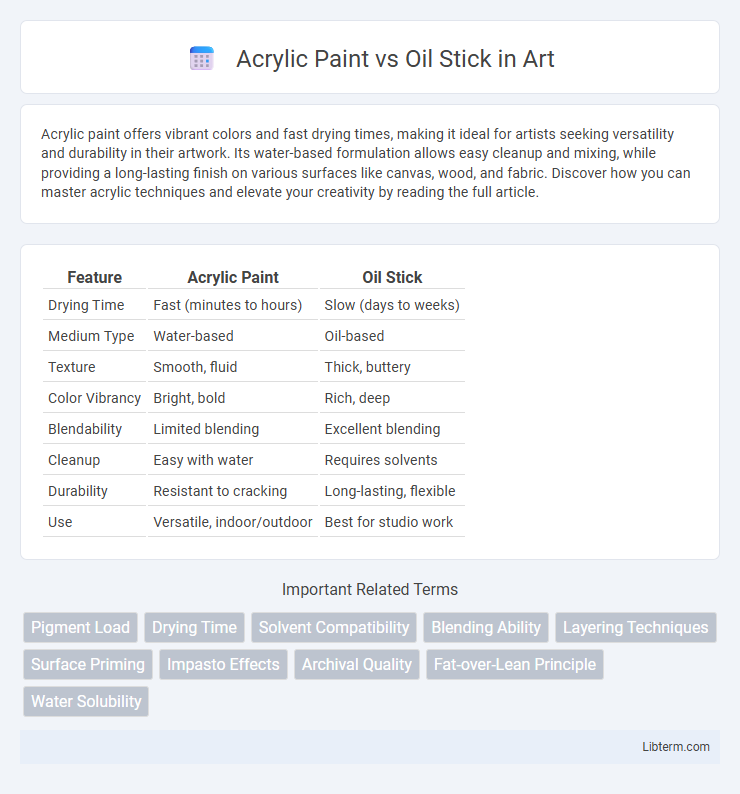Acrylic paint offers vibrant colors and fast drying times, making it ideal for artists seeking versatility and durability in their artwork. Its water-based formulation allows easy cleanup and mixing, while providing a long-lasting finish on various surfaces like canvas, wood, and fabric. Discover how you can master acrylic techniques and elevate your creativity by reading the full article.
Table of Comparison
| Feature | Acrylic Paint | Oil Stick |
|---|---|---|
| Drying Time | Fast (minutes to hours) | Slow (days to weeks) |
| Medium Type | Water-based | Oil-based |
| Texture | Smooth, fluid | Thick, buttery |
| Color Vibrancy | Bright, bold | Rich, deep |
| Blendability | Limited blending | Excellent blending |
| Cleanup | Easy with water | Requires solvents |
| Durability | Resistant to cracking | Long-lasting, flexible |
| Use | Versatile, indoor/outdoor | Best for studio work |
Introduction to Acrylic Paint and Oil Sticks
Acrylic paint is a fast-drying medium composed of pigment suspended in acrylic polymer emulsion, widely valued for its versatility, vibrant colors, and water solubility when wet. Oil sticks, also known as oil paint sticks, are oil-based, solid drawing tools that combine traditional oil paint with a crayon-like form, offering rich texture and blending capabilities without the need for brushes. Both mediums cater to artists seeking different tactile experiences and drying times, with acrylics favored for quick layering and oil sticks prized for their buttery consistency and extended blending window.
Composition and Chemical Differences
Acrylic paint consists of pigment suspended in an acrylic polymer emulsion, which dries quickly through water evaporation and forms a flexible, water-resistant film. Oil sticks are made of pigment bound in a non-drying oil such as linseed or safflower oil, combined with waxes and stabilizers, resulting in a slow-drying, malleable medium similar to traditional oil paints. Chemically, acrylics are water-based and polymerize through a process called coalescence, while oil sticks undergo oxidation and polymerization reactions during slow drying, influencing texture and blending properties.
Drying Time and Workability
Acrylic paint dries rapidly, typically within 15 to 30 minutes, allowing for quick layering and adjustments, which enhances workability for artists seeking fast results. Oil sticks have a much longer drying time, ranging from several days to weeks, providing extended blending and manipulation opportunities on the canvas. The drying speed of acrylic paint favors dynamic, fast-paced techniques, while oil sticks support detailed, textured applications due to their slow drying nature.
Color Vibrancy and Pigment Load
Acrylic paint exhibits high color vibrancy due to its water-based formula that allows pigments to remain bright and intense when dry. Oil sticks contain a higher pigment load, providing rich, buttery textures and deep, saturated hues that enhance color depth. The fast-drying nature of acrylics preserves sharp vibrancy, while oil sticks offer longer open times for blending and layering with luxurious pigment density.
Texture and Application Techniques
Acrylic paint offers a smooth, fast-drying texture ideal for layering and detailed brushwork, while oil sticks provide a rich, buttery consistency suited for bold, expressive strokes and direct application. Acrylics dry quickly, enabling artists to build textures through glazing and impasto, whereas oil sticks allow for prolonged blending and manipulation on the canvas surface. Techniques with acrylic emphasize precision and controlled layering, contrasting with oil sticks' tactile, spontaneous mark-making and sculptural effects.
Surface Compatibility and Preparation
Acrylic paint adheres effectively to a wide range of surfaces including canvas, wood, paper, and metal, requiring minimal surface preparation beyond cleaning and priming for optimal adhesion. Oil sticks work best on primed canvas or specially prepared surfaces to prevent poor adhesion and prolonged drying times due to their oil-based composition. Proper surface preparation, such as sanding and applying a suitable ground or primer, enhances durability and prevents cracking or peeling for both acrylic paint and oil stick applications.
Layering, Blending, and Reworking
Acrylic paint dries quickly, enabling rapid layering and easy reworking but can limit blending time due to its fast drying nature. Oil sticks, made from oil paint in a solid form, offer extended blending time and allow smooth transitions between colors, making them ideal for detailed blending techniques. Reworking oil sticks is easier over longer periods because of their slow drying properties, whereas acrylic layers can be reworked only shortly after application before they set permanently.
Longevity and Archival Quality
Acrylic paint offers excellent longevity due to its fast-drying, flexible polymer base resistant to cracking and yellowing over time, ensuring stable color retention and archival quality. Oil sticks, made from pigment and oil in a solid form, provide rich texture and blending capabilities but are more prone to surface cracking and color shifts if not properly sealed, potentially affecting long-term preservation. Both media require appropriate substrates and varnishing techniques to enhance durability, with acrylics generally favored for superior archival performance in museum standards.
Cleanup and Safety Considerations
Acrylic paint offers easy cleanup with water and soap, making it ideal for quick removal and safer handling compared to oil sticks, which require solvents like mineral spirits or turpentine that can be toxic and produce strong fumes. Oil sticks, while providing rich texture and blending capabilities, necessitate proper ventilation and protective gloves to minimize skin exposure and inhalation risks. Choosing acrylic paint reduces hazardous waste and environmental impact, supporting a safer workspace and more straightforward maintenance.
Choosing the Right Medium for Your Art
Acrylic paint offers fast drying times and vibrant, water-resistant colors, making it ideal for artists seeking flexibility and quick layering. Oil sticks provide rich, buttery textures and extended blending periods, perfect for expressive, impasto techniques and traditional oil-like finishes. Consider your preferred working speed, desired texture, and the intended durability of your artwork when choosing between acrylic paint and oil sticks.
Acrylic Paint Infographic

 libterm.com
libterm.com